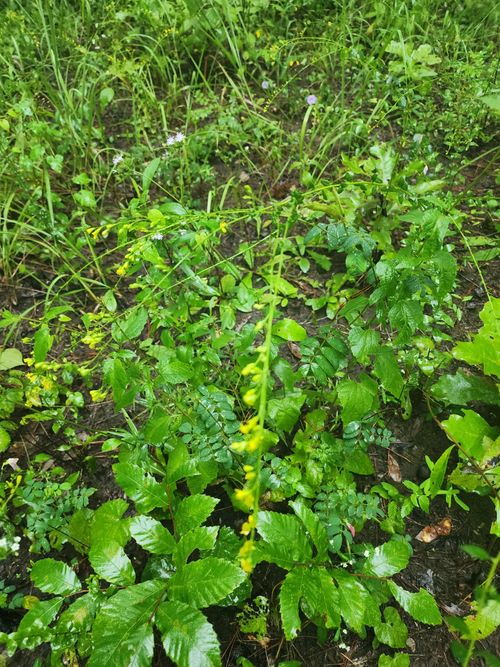There are nearly 150 species of butterflies that have been found in Pennsylvania. All of these species help to pollinate plants and act to move energy through the ecosystem. These butterflies are found in nearly all of the habitats in Pennsylvania. In this post we will talk about the six species of swallowtail butterflies (Papilinoidae) that you can host in your butterfly garden in Crawford County, Pennsylvania.
Table of Contents for Swallowtail Butterflies and Host Plants in Crawford County, PA
Location of Crawford County, Pennsylvania

Crawford County, Pennsylvania is located in the northwestern part of the state, south of Lake Erie. The major cities in Crawford County include Meadville and Titusville.
USDA Plant Hardiness Zones in Crawford County, Pennsylvania

Crawford County, Pennsylvania is located in plant hardiness zone 6 with most of the county in zone 6a and a few scattered places of zone 6b. When selecting plants you will want to get those that can handle temperatures as cold as -100F to be sure they will survive.
Pipevine Swallowtail (Battus philenor) and its host plants in Crawford County, PA




Pipevine Swallowtail (Battus philenor)
The pipevine swallowtail flies throughout the United States, except for the Pacific Northwest.
It has orange-brown eggs that are laid on the host plant. The black to brown to red caterpillar with orange markings comes out in the spring. They then overwinter as a pupa (Monroe and Wright 2017).
In the spring and summer the adult butterflies start to fly. They have a wingspan of 2.5 in (6.4 cm) to 5 in (12.7 cm) inches and are black colored with white markings.
Plants that Host the Pipevine Swallowtail
The Pipevine Swallowtail is generally hosted by members of the birthwort family (Aristolochiaceae). In Crawford County, PA these include:
- Wild Ginger (Asarum canadense): a herbaceous plant.
- Virginia Snakeroot (Endodeca serpentaria): a herbaceous plant. This plant is also known commonly as Aristolochia serpentaria.
- Pipevine (Isotrema macrophyllum): As the name would suggest this is the main host plant and a vine.
- Woolly Pipevine (Isotrema tomentosa): a herbaceous plant that is native near to Crawford County, PA.


Giant Swallowtail (Papilo cresphontes) and its host plants in Crawford County, PA
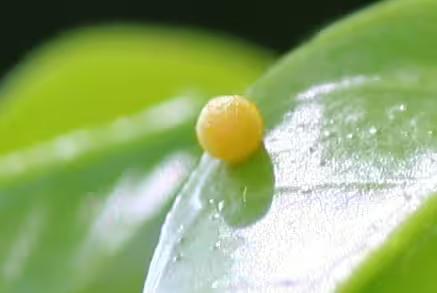



Giant Swallowtail (Papilio cresphontes)
The giant swallowtail flies throughout the United States and southeast Canada, except for the northwest. Beyond North America it ranges into Central America and the Caribbean Islands. It is the largest butterfly in North America (Wikipedia).
The giant swallowtail has brownish-orange eggs that are laid on the host plants. The caterpillars have five stages or instars before pupating, which takes about two weeks. The adult butterflies have a wingspans ranging from about 5.5 in (14.0 cm) to 7.5 in (19.1 cm) and are black and yellow colored.
Plants that Host the Giant Swallowtail
The giant swallowtail is hosted by members of the Rutaceae, of which there are two primary plants in Crawford County. These include:
- Toothache tree (Zanthoxylum americanum) — a small to medium sized tree
- Common Hoptree (Ptelea trifoliata) — a rare small tree in Pennsylvania

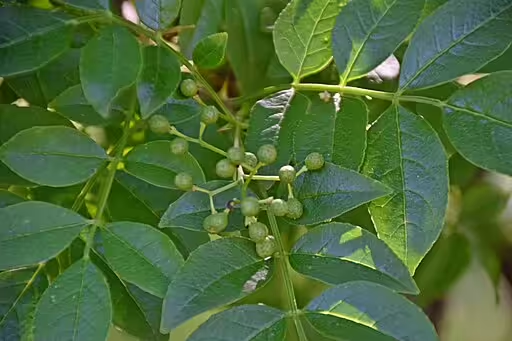
Common Rue (Ruta graveolens), an introduced plant, can also be planted in Crawford County.
Eastern Tiger Swallowtail (Papilio glaucus) and its host plants in Crawford County, PA

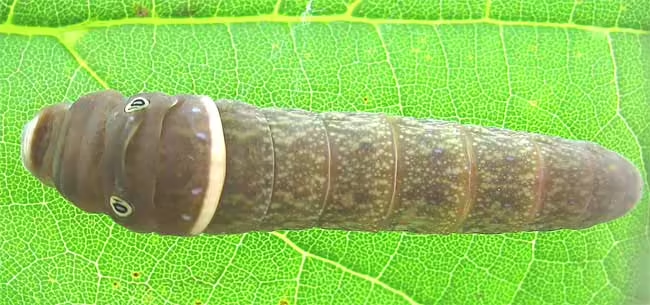

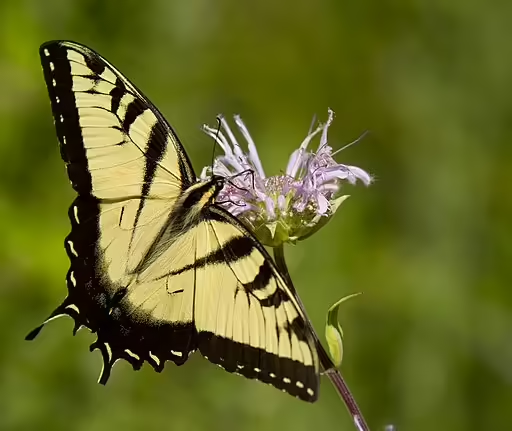

Eastern Tiger Swallowtail (Papilio glaucus)
The Eastern Tiger swallowtail flies in the mid-western and eastern United States from the Rocky Mountains and east. In the Eastern US it is likely one of the most distinctive swallowtails.
The light green eggs are laid on the host plants. The caterpillar has five stages; with the first three a brown color and the last two as a green color. The brown chrysalis is placed in on trunks or on fallen leaves.
Eastern tiger swallowtail adults have a wingspan of 3.0 in (7.6 cm) to 5.5 in (14.0 cm) and have two color schemes. The yellow and black is the most distinctive, but the females also have a dark black phase that mimics the pipevine swallowtail (see image). Generally there are two broods in Pennsylvania (Monroe and Wright 2017).
Plants that Host the Eastern Tiger Swallowtail
The eastern tiger swallowtail is a generalist and uses members of a number of genera as host plants. Some species in Crawford County, PA include:
- Members of the Prunus genus (Cherries and Plums)
- Members of the Betula genus (Birch)
- Members of the Populus genus (Poplar and Cottonwood)
- Members of the Fraxinus genus (Ash)
- Tuliptree (Liriodendron tulipifera)


Note: There is a hybrid of the eastern tiger swallowtail (Papilio glaucus) and the Canadian swallowtail (Papilio candensis) in Crawford County. In the Appalachians this hybrid is thought to have become the Appalachian swallowtail (Papilio appalachiensis). The hybrid uses black cherry (Prunus serotina) as a host plant (Monroe and Wright 2017).
Black Swallowtail (Papilio polyxenes) and its host plants in Crawford County, PA

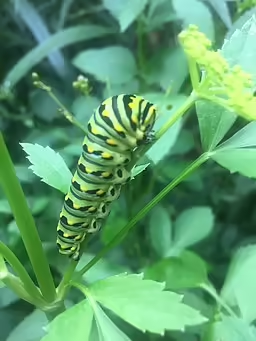

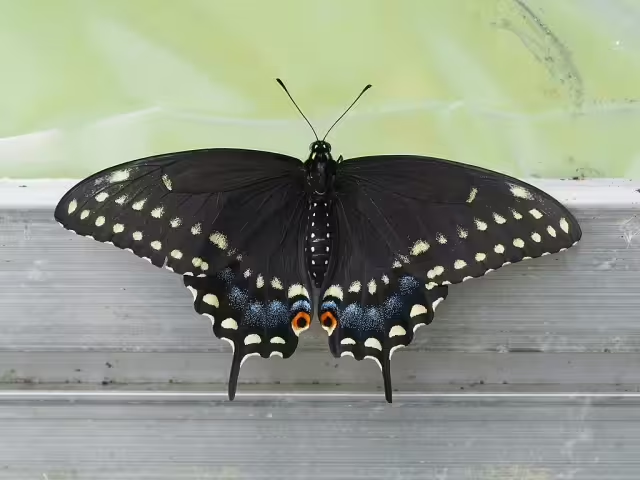
Black Swallowtail (Papilio polyxenes)
The Black Swallowtail flies in most of the United States, except for the Northwest.
The yellow eggs are laid on the host plants and take about a week to hatch. The caterpillars are at first black colored but later have green, black, and yellow coloring and last from a week to a month. The butterflies then survive the winter as a chrysalis.
Black swallowtail adults have a wingspan of 2.5 in (6.4 cm) to 3.5 in (8.9 cm) and are black colored with yellow spots along the wings and a red eyepsot near the tail on the top. The underside has orange spots.
Plants that Host the Black Swallowtail
The black swallowtail is a generalist and uses members of the carrot family as host plants. Some examples of carrot family members in Crawford County include:
- Purple-stem Angelica (Angelica atropurpurea): a herbaceous plant
- Hairy Angelica (Angelica venenosa): a herbacous plant
- Spotted Water-Hemlock (Cicuta maculata): a herbaceous plant
- American Cow-Parsnip (Heracleum maximum): a herbaceous plant
- Hairy Sweet Cicely (Osmorhiza claytonii): a herbaceous plant
- Aniseroot (Osmorhiza longistylis): a herbaceous plant
- Wild Parsnip (Pastinaca sativa): a herbaceous plant
- Hemlock Water-Parsnip (Sium suave): a herbaceous plant
- Heart-leaf Alexander (Zizia aptera): a herbaceous plant
- Golden Alexanders (Zizia aurea): a herbaceous plant


Spicebush Swallowtail (Papilo troilus) and its host plants in Crawford County, PA



Spicebush Swallowtail (Papilio troilus)
The spicebush swallowtail flies in the mid-western and eastern United States.
The greenish eggs are laid on the leaves of spicebush. The caterpillars are brown at first but then turn yellow. The chrysalis is attached to leaves on the ground.
Spicebush swallowtail adults have a wingspan of 3.0 in (7.6 cm) to 4.0 in (10.2 cm) and are black with white spots along the bottom and a red eyespot on the bottom middle.
Plants that Host the Spicebush Swallowtail
As the common name would suggest, spicebush (Lindera benzoin), is a host plant for the spicebush swallowtail as is the sassafras (Sassafras albidum), both of which are members of the Laurel Family (Lauraceae). Both of these species are found in Crawford County and the spicebush swallowtail only feeds on members of the Lauraceae (Scriber et al 2008).
- Sassafras (Sassafras albidum) — An understory tree


Zebra Swallowtail (Protographium marcellus) and its host plants in Crawford County, PA



Zebra Swallowtail (Protographium marcellus)
The Zebra swallowtail flies in the mid-western and eastern United States.
The green to brown eggs are laid on the leaves of the host plant, which is the pawpaw. The caterpillars have two color variations, first black and then later stages are more colorful with green and yellow stripes. The brown chrysalis can overwinter in places of cold temperatures (Wikipedia).
The black and white multi-colored adults have a wingspan of 2.5 in (6.4 cm) to 4.5 in (11.4 cm) and fly from February to December with a more restricted season in more northern places. The early season brood can be smaller and has a shorter tail than the later summer brood that is larger and has a long tail (animaldiversity.org).
Plants that Host the Zebra Swallowtail
The zebra swallowtail uses members of the Custard Apple Family (Annonaceae) as host plants. In Crawford County, pawpaw (Asimina triloba), an understory tree, is used as a host. This tree is near the northern limit of its range in Crawford County.

Nectar Plants to Consider Putting in Your Garden
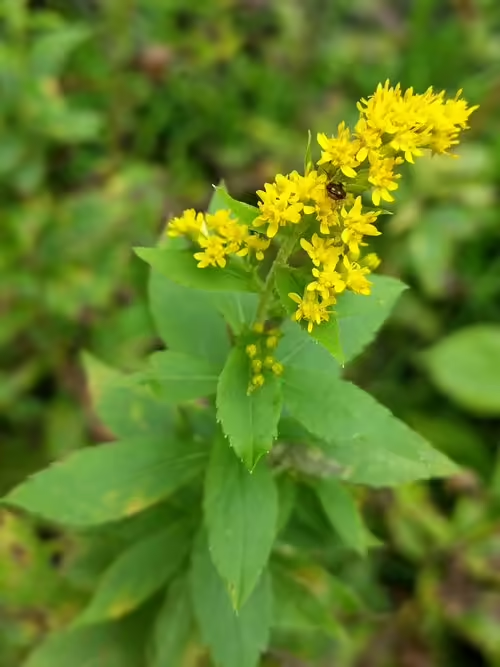
While the swallowtails need certain species of plants to use as hosts, the adults also need nectar plants to visit in order get nourishment. Nectar plants can also help other insects such as bees. Some common nectar plants that can be grown in Crawford County, PA include:
- Goldenrods (Solidago spp.)
- Joe-Pye-Weeds (Eutrochium spp.)
- Milkweeds (Asclepias spp.) — Also benefit the Monarch Butterfly (Danaus plexippus)
- Asters (Symphyotrichum spp.)
- Coneflowers (Rudbeckia spp.)
- Blazing Stars (Liatris spp.)
Frequently Asked Questions
How much land do I need to start a butterfly garden?
Every plant that you can grow can make a difference for visitors to your garden, especially in urban areas. Potted plants are also useful en masse for pollinators. When planting your garden, make sure you plant both the host plants and nectar plants for the adults to feed on.
Where should I get my plants?
For pollinators, it is best to have native plant species. The insects will be used to these plants more than ones from other places. Be sure you get your plants from a reputable nursery does not use neocontinids that would harm visitors to your garden.
Are there gardens near me, where I can see an example of a butterfly garden?
There are several gardens in or near to Crawford County, PA that can be visited in order to get ideas for your Butterfly Garden. These include the:
Erie Zoo: a zoo with a variety of gardens located to the north in Erie, Pa.
Goodell Gardens & Homestead: a garden in Edinboro, Pa that has native plants and a pollinator garden.
Lake Erie Arboretum: an arboretum in Erie, Pa with a variety of local trees.
Serenity Botanical Gardens: a garden south of Cambridge Springs, Pa that contains a butterfly garden.
The Arboretum at Penn State Behrend: arboretum in Erie, Pa that has a number of native trees.
Books where you can find out more about Butterfly Gardening in Crawford County, PA
- Clausen, Ruth Rogers and Gregory D. Tepper. 2021. Deer-Resistant Native Plants for the Northeast. Little and Brown. 208 pp.
- Daniels, Jaret C. 2022. Garden Bugs & Insects of the Northeast: Identify Pollinators, Pests, and Other Garden Visitors. Adventure Quick Guides.
- Daniels, Jaret C. 2022. Native Plant Gardening for Birds, Bees & Butterflies. Northeast – Nature Friendly Gardens. 276 pp.
- Daniels, Jaret C. 2019. Butterflies of the Northeast. Adventure Publications.
- Lorimer, Uli. 2022. The Northeast Native Plant Primer: 235 Plants for an Earth-Friendly Garden. Little Brown Publishers. 250 pp.
- Mehl, Geoffrey L. 2016. Pennsylvania Naturally – A Gardener’s Guide to Sustainable Landscaping. Pennystone Books. 396 pp.
- Mehl, Geoffrey L. 2012. Pennsylvania Native Plants/Perennials – Habitat and Culture. Pennystone Books. 202 pp.
- Monroe, James L. and David M. Wright. 2017. Butterflies of Pennsylania. (Pittsburgh, PA: University of Pittsburgh Press). 304 pp.
Affiliate Disclosure: When you click on links to various merchants on this site and make a purchase, this can result in this site earning a commission at no extra cost to you. Affiliate programs include, but are not limited to, the eBay Partner Network and Blackwell’s Books.
References
- Monroe, James L. and David M. Wright. 2017. Butterflies of Pennsylvania. (Pittsburgh, PA: University of Pittsburgh Press). 304 pp.
- Scriber, Mark J., Michelle L. Larsen, and Myron P. Zalucki. 2008. Responses of North American Papilio troilus and P. glaucus to potential hosts from Australia. Journal of the Lepidopterists’ Society 62: 18-30.

